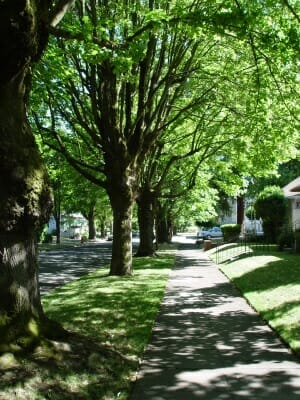 As wet as our weather is in the winter months, it can be just as dry in the summer. With that in mind, it’s definitely not the best time to plant new trees. But for those you already have, you need to know how to care for them in the warmer and drier months of June through September.
As wet as our weather is in the winter months, it can be just as dry in the summer. With that in mind, it’s definitely not the best time to plant new trees. But for those you already have, you need to know how to care for them in the warmer and drier months of June through September.
July and August routinely see less than an inch of rain each month. It’s important that you give your trees ample amounts of water to make up for the lack of rainfall, particularly for young trees (in their first three years). If you aren’t frequently watering your trees, they become stressed, which brings about the risk for insects and diseases, improper root growth and overall stunting the tree’s growth.
It’s not enough to simply water them, though. Don’t rush it by dumping all the water once. It’s important that the water runs deep to avoid the aforementioned health problems. So when you see water pooling, stop and give it time to soak through the soil, then continue.
New trees need about 5-10 gallons of water a few times a week in the summer. Mature trees need about 1 gallon of water per inch of trunk diameter on the hottest days of summer, including 90 plus degree weather or exceptionally long periods of dry weather. The precise needs depend on how dry the weather is, the tree’s species, and size.
If you use a hose, water your trees with low-to-medium pressure to ensure optimal absorption. Since you aren’t dumping actual gallons of water, you will want to get a fairly accurate estimate of how much is coming from your hose. The best solution is to test it yourself by filling a gallon container and time how long it takes. Use that time to gauge how long you need to water your tree. Another solution is to use a five gallon bucket with a pen sized hole in the bottom
Some other quick tree watering tips:
- Pay close attention to trees near pavement, since they are apt to be exposed to more heat.
- Use organic mulch. This helps conserve soil moisture and temperature. Figure about 2 to 4 inches of mulch will do the trick.
- During extreme droughts and mandatory water restrictions, give your trees priority over the lawn, since grass is easier to restore and trees take years to achieve their current state.
- Avoid using fertilizers around trees during dry months and be very cautious about the use of pesticides.
- Understand that just because you have irrigation watering your lawn that water may not be making it down to the tree root zone.
And for more tips and tricks about how you can care for your trees year-round see our seasonal tree maintenance plan.